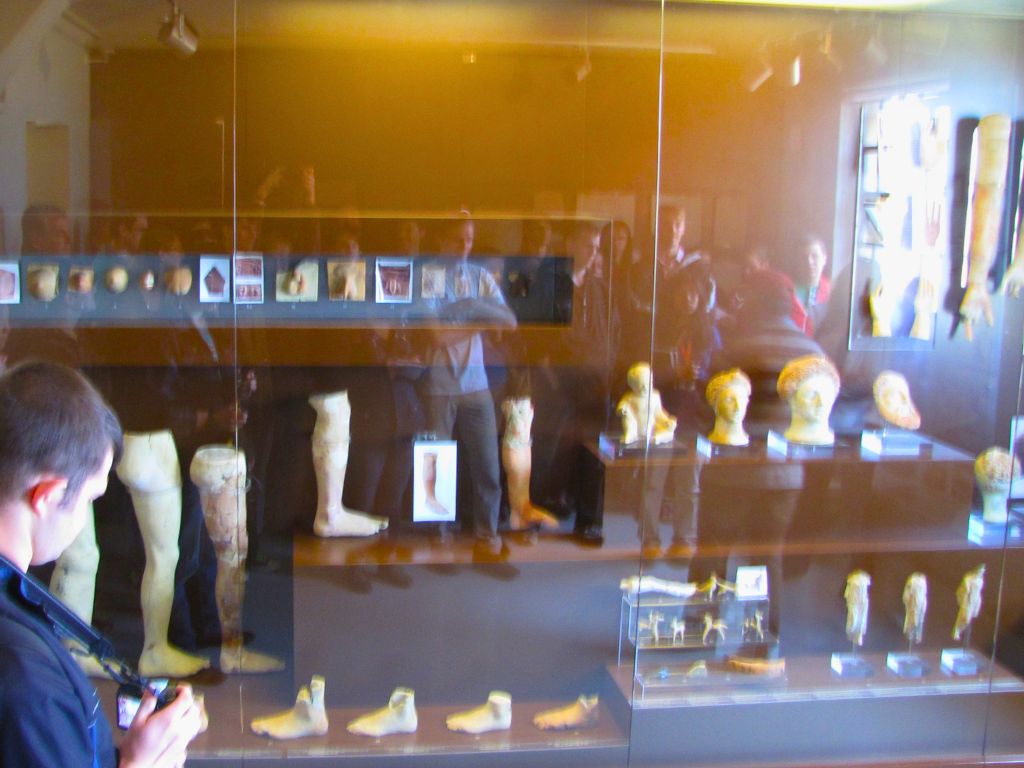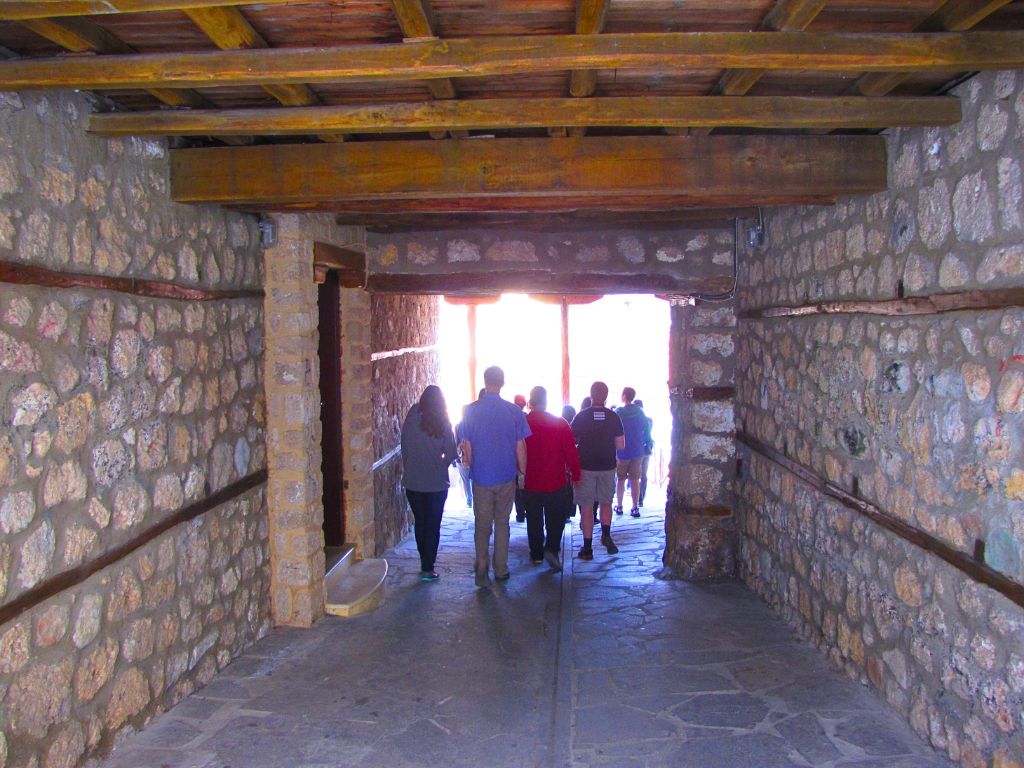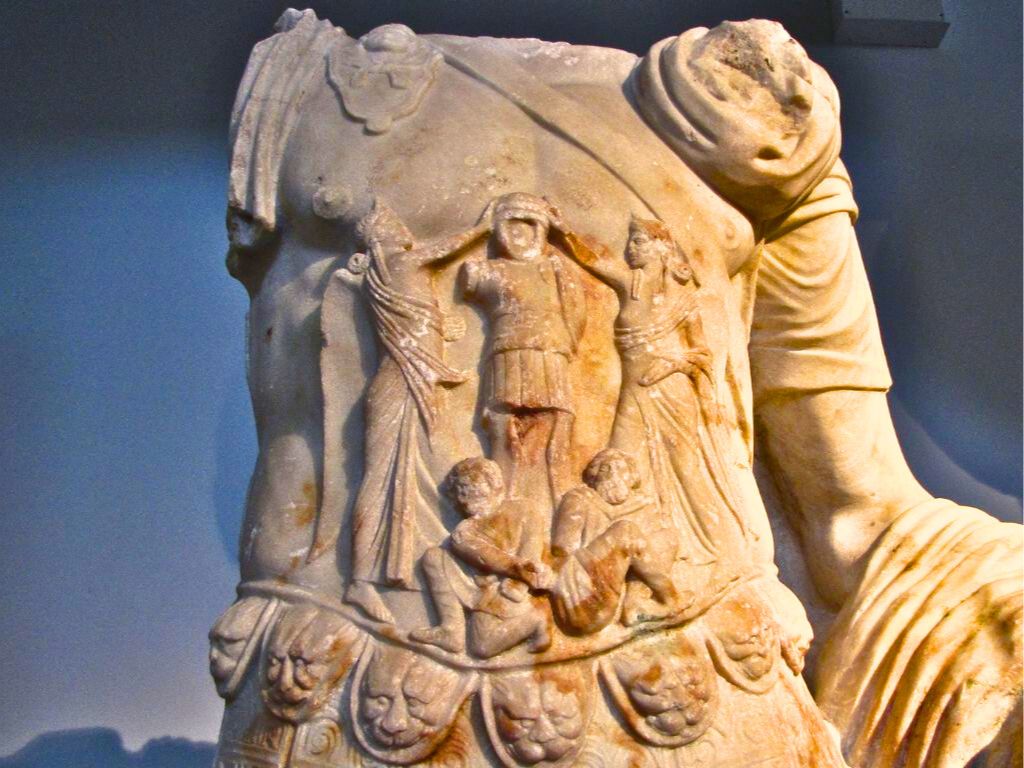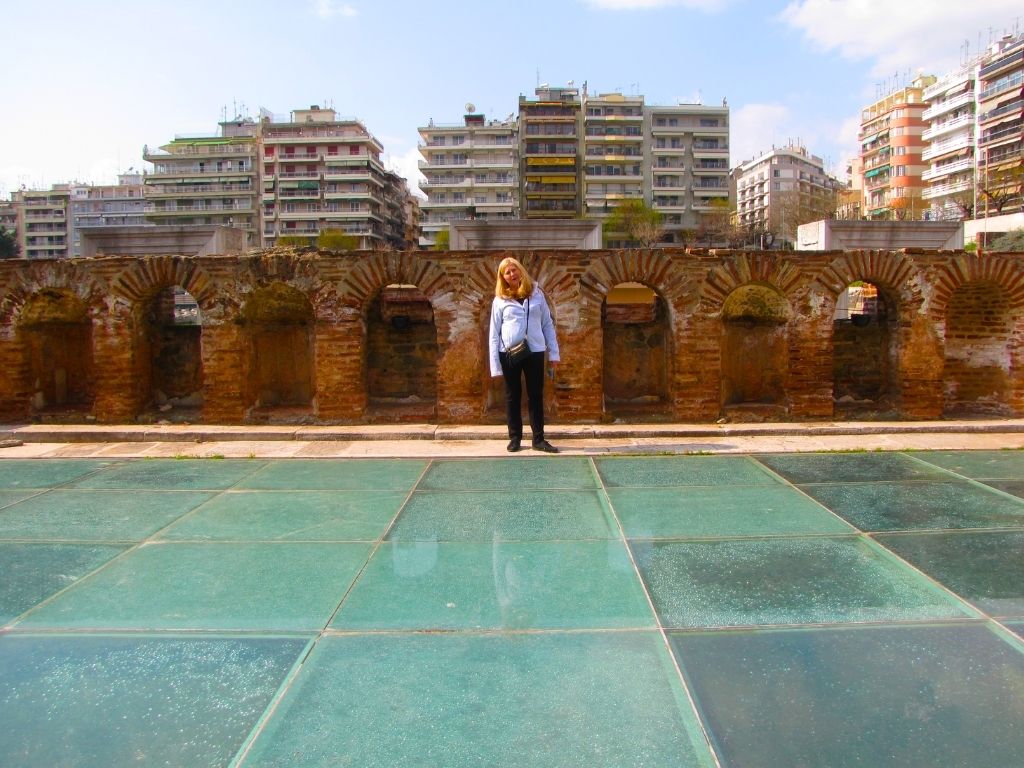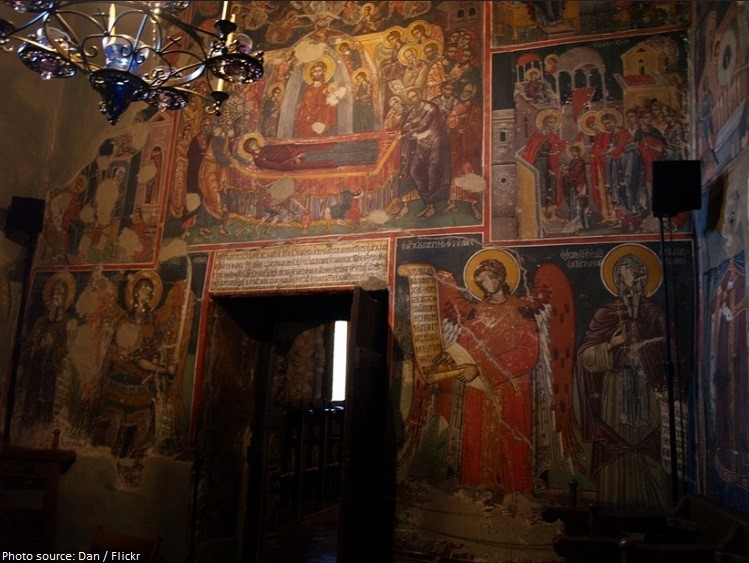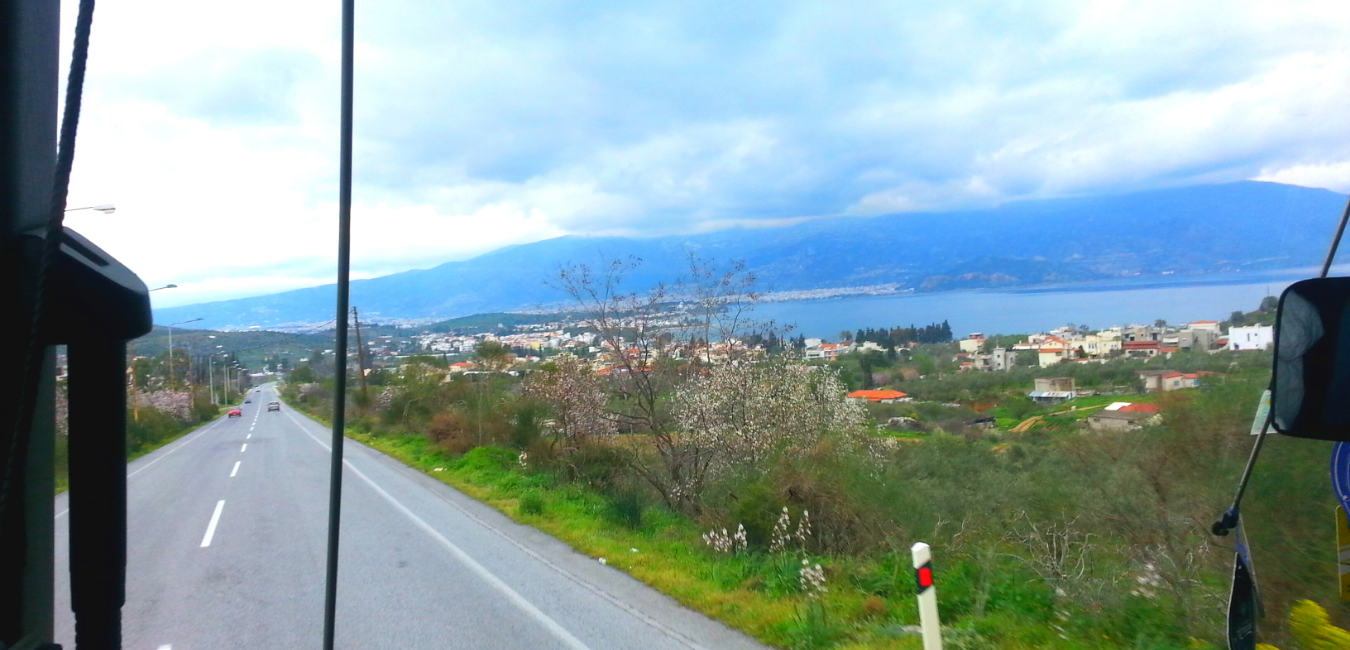Tour locations on this map include Thebes (Thiva), Thermopylae, Volos, Leptokarya, Meteora, Kavala & Krinides & Philippi, Thessaloniki, Berea (Veria) Corfu Island, Corinth and Athens.
Read MoreTake the First Step in Faith
Our Mission: We inspire you to travel. Our Roadmap: We share our travel experience with you, so that you can travel to Greece, too. Take the first step in faith. You don’t have to see the whole staircase, just take the first step. Our Vision: Travel. Make Friends Have Fun.
Read More60. ATHENS | The Marble Stadium | Theodosius | The Pilgrim Church | Dromeas | The Runner
The upper section of the Marble Stadium of Athens, added in the second century AD, is part of the stadium that housed the first modern Olympic Games in 1896 and serves as the endpoint of the classical marathon every year. The stadium’s lower-level dates back to the fourth century BC. […]
Read More59. ATHENS | Lykavittos Hill
See Lykavittos Hill in the distance, (Λυκαβηττός λόφος) the highest peak in Athens. In antiquity, it was located outside the city walls. Today, its summit is occupied by a chapel dedicated to St. George.
Read More58. ATHENS | Temple of Zeus, The Olympieion | Athens in 2 AD
At the Temple of Zeus, also known as The Olympieion, in the Corinthian style, today we have only sixteen columns remaining – out of the original one hundred and four. The surviving columns of the Temple of Zeus are located in the center of Athens, Greece. The temple originally had […]
Read More57. ATHENS | Instructions to the Church | Equality of the Members | The Experience of the Life of the Church
Paul wrote to the church and gave them instructions on their need to provide the good life to everyone in the church. The Apostle Paul wanted the church members to be equal. This included “culturally proper ladies” and those who had left a life of prostitution and traded it for life […]
Read More56. ATHENS | Classical Theater | Prometheus | Substitutionary Atonement
A famous playwright is Aeschylus. Have you heard about the Titan Prometheus? Aeschylus wrote a trilogy about Prometheus: ‘Prometheus Fire-Holder,’ ‘Prometheus Bound,’ and ‘Prometheus Liberated.’ The first part of the trilogy shows how Prometheus stole fire from the gods and gave it to humans, making himself good to the humans, […]
Read More55. ATHENS | Classical Theater | Oedipus
“Have you heard anything about classical theater? Do you have a favorite author or a favorite play from that time? Have you heard about Oedipus? Do you have a favorite topic you’d like us to discuss? Or we can continue talking about Oedipus. I would like to start with the […]
Read More54. ATHENS | Theater of Dionysus | Philippians 1:30 | Colossians 2:1 | 1 Timothy 6:12
The ruins of the Temple of Dionysus, possibly built at the beginning of the 6th century BC, and just where we are now, you would find the orchestra of the theater, which was a threshing floor during the festivals of Dionysus. It wasn’t used by the farmers of Athens to […]
Read More53. ATHENS | Asklepieion | The Hospital of Athens | Ancient Roads
Facing south we have the Asklepieion, (Ἀσκληπιεῖον) the hospital of Athens, on the southern slope of the Acropolis. Do you know something about the ancient hospitals? More than 300 hospitals/temples dedicated to Asclepius have been discovered, the biggest one being in Pergamum. The Pergamian Asclepieion is like a town. The […]
Read More52. ATHENS | Erectheion on the Acropolis of Athens
At the Erectheion on the Acropolis of Athens, one part of this ancient temple was dedicated to Poseidon, the god of the sea. Another part, the part that faced the city was dedicated to Athena, the goddess of the city court/wisdom. Athenians believed there was a contest between Poseidon and […]
Read More51. ATHENS | Rock of the Ecclesia | Temple of Nike | The Parthenon
At the rock of the Ecclesia, you can see the three steps of the Bema. Look for a little cliff, and the steps carved on the side of the cliff. Now, on this side, here we have the gates. Right in the middle are the five doors on the marble […]
Read More50. ATHENS | Introduction to the Acropolis of Athens | The Odeion | The Philopappos Monument
I would like to continue the Introduction to the Acropolis. I would like to speak a little bit about an attack that was organized against the city-state of Athens by a superpower at the very time when democracy was born here. When this little miracle called democracy started in Athens, […]
Read More49. ATHENS | Mars Hill | Mark 10:17-18 | Matthew 19:16-17 | Luke 18:18-19 | Acts 17: 15-34
Mars Hill in Athens, Greece, became important for Athenian society after the monarchy was abolished. For the first time, the system called oligarchy was established, and power passed into the hands of the Royal Council. It was necessary for the Royal Council to go up Mars Hill to have its […]
Read More48. ATHENS | Mars Hill | The Bema | The Stoa | The Sermon of the Apostle Paul | Acts 17:22-31
Mars Hill was important to the public life of Athens after the monarchy was abolished. Mars Hill overlooks the square of the Athenian Agora. Remember the Bema, of course (and the Bema in Philippi, Greece that you have already seen.) Read the sign there and look at this rectangular and […]
Read More47. ATHENS | The Concept of the Body | Harmonious Cooperation of All the Members of the Body | The Meaning of Democracy
I would like to remind you that God never left Himself unrevealed to the nations and to the Gentiles. The Apostle Paul, several times, repeats that idea. Remember, in the letter to Romans, Paul asks the question, “Is God only the God of Israel or the God of the nations? […]
Read More46. ATHENS | Where Athenian Democracy was Born
The first agora in Western civilization appeared in Athens, at the end of the sixth century BC. This is where Athenian democracy was born, which opened a new era in world culture. At the Agora in Athens we have the ruins of the administrative and the religious sections of the […]
Read More45. CORINTH | Acts 18:4-6 | I Corinthians 12:12-22 | Colossians 2:15 | I Corinthians 11 | I Corinthians 9:13 | 1 Corinthians 13 | Romans 12:1 | Matthew 11:11 | John 11:13
Now we are going to see the Archeological Museum of Ancient Corinth. First, I would like you to see a design. Look at the hanging on the wall. We have an inscription on a door lintel. The first syllable of the word, synagogue, is missing. And the second part of […]
Read More44. CORINTH | 2 Corinthians 10:4 | 1 Corinthians 10:25 | 1 Corinthians 13 | Romans 12:1 | Amos 7:10-12 | 1 Corinthians 10:4
Peirene, the main fountain of Corinth, is a prehistoric fountain, used in classical times and even prior to that. The villagers could come with their jars to take fresh water from the spring. Peirene was in use until the Second World War. Behind the arches are water containers. In front […]
Read More43. CORINTH | The Gallio Inscription | The Bema | Acts 18:12-13
When the Apostle Paul came to Corinth, he made tents to sell. And he found another couple, Aquila and Priscilla, who were also tentmakers. But Corinth was the richest city of that time, a mega city, a city which offered hospitality of all kinds, including hotel facilities and guest houses. […]
Read More42. CORINTH | We are Disabled to Fulfill the Divine Standards | He was The Hubrist | We are the Sinners
…Yes, if you accept the authority, recognize this authority and you place yourself under this authority… or you put an x to this authority? Actually, hell is made by God, not for the human, but for the devil and his followers. The human is going to arrive finally in hell […]
Read More41. CORINTH | Romans 12:1 | Mark 16:15 | Acts 15:11 | John 19:13 | Matthew 27:19 | Acts 12 :21 | Acts 25:6 | Acts 25:10
The Apostle Paul uses his experience in the city of Corinth, Greece to clarify his message. For example, Paul used a visible, touchable illustration of daily life in Corinth when he wrote Romans 12:1. At the time of the Apostle Paul, two cults were present in Corinth, the Cults of […]
Read More40. CORINTH | Romans 16:23 | Acts 19:22 | 2 Timothy 4:20 | 1 Corinthians 16:19 | 1 Corinthians 11:5,6
The Apostle Paul visited Corinth in the middle of the first century AD. According to scholars, the Apostle Paul came back to Corinth at least three times. After his first visit he stayed in Corinth one year and a half. (At Ephesus he stayed three entire years.) From Corinth, Paul […]
Read More39. AIGAI | Museum of the Royal Graves of Aigai | Daniel 8 | Daniel 11 | Luke 16:19-31 | Galatians | 1 Corinthians 9:24, 25 | Matthew 26:29 | Matthew 16:18 | Acts 2:31 | 1 Peter 3: 18,19 | 1 Corinthians 15:55 | Revelation 20:14
We toured the Museum of the Royal Graves of Aigai, but were not able to get any pictures. Here is what we learned: In the Old Testament in Daniel 8, the ancient prophet asked, “What is this male goat and the ram?” The archangel Gabrielle said to him, “Look, the male […]
Read More38. VERIA | BEREA | The Four Portions of the Kingdom of Macedonia | Acts 16:12 | Acts 17:10-15
Berea, Greece was once a part of the Kingdom of Macedonia. In 148 BC Andriscus was assassinated and the Kingdom of Macedonia (a Roman providence) was divided into four portions (with communication restrictions put in place between the people of the four portions – to keep the people subject to the Romans. Restrictions […]
Read More37. THESSALONIKI | Disarming the Bodies of the Dead Enemies | Fixing the Spoils on a Long Wooden Pole | Displaying the Spoils | Colossians 2:15
In ancient history, soldiers disarmed the bodies of their dead enemies, meaning they removed the sword, spear, and any tools of destruction from the now-dead enemy and he brought them home. The soldier affixed his spoils to the top of a long wooden pole. Why? At the victory celebration the […]
Read More36. THESSALONIKI | The Thessaloniki Forum | The Thessaloniki Theater | They Dragged Jason and Some Other Believers | Acts 17:6b-9
The Forum in Thessaloniki, Greece was the seat of the City Council, the seat of the politarches (πολιτάρχης.) During an excavation archeologists found the row of their seats, which had been buried underground, and today we can see the excavated row of seats under a glass floor at the Forum […]
Read More35. THESSALONIKI | Archeological Museum of Thessaloniki | 2 Peter 1:4 | Genesis 4:1 | Numbers 21:6-9 | 3 Approaches to Divinity | Anthropomorphism | Theogony | Theosis | Asclepius | A Prefiguration of Jesus Christ
The Ancient Greeks had three very special concepts in their approach to Divinity, all of them were daringly sacrilegious for a faithful Jew of the Old Testament. These three concepts were: All of these three concepts, being totally sacrilegious and disgusting for a faithful Jew of the Old Testament, are […]
Read More34. THESSALONIKI | Archeological Museum of Thessaloniki | Column from the Via Ignatia | The Symposium | Socrates | Acts 19:29 | 2 Corinthians 9:2,4 | Daniel 8:20-21 | Acts 27:9-44 | 2 Corinthians 11:25-26
The Macedonian language that some people claim that they speak today has nothing to do with Macedonian inscriptions. The language that the Macedonians used in antiquity, was not Slavic, but definitely, without any doubt, was Greek. Slavic Macedonians cannot name themselves as “The Macedonians.” Rather, they are “Slavic Macedonians.” Macedonians […]
Read More33. THESSALONIKI | Archeological Museum of Thessaloniki | 1 A.D. Greek Inscription ΟΙ ΠΟΛΙΤΑΡΧΑΙ | Paul and The City Authorities in Thessaloniki | Daniel 8 | Acts 19:29 | 2 Corinthians 9:2,4 | Acts 17:5-9
Prior to 1887 a very specific term for The City Authorities had never been found inscribed anywhere. This caused doubt. But then, in the Archeological Museum of Thessaloniki, wan early inscription was found from 1 A.D. The Greek inscription, ΟΙ ΠΟΛΙΤΑΡΧΑΙ, is important for Christian apologetics. ΟΙ ΠΟΛΙΤΑΡΧΑΙ means “The City […]
Read More32. THESSALONIKI | Archeological Museum of Thessaloniki | Classical History of Greece | Gold | 2 Corinthians 4:7 | 1 Corinthians 13: 12a | Philippians 2:17 | Revelation 16:1 | Acts: 17: 6b-8 | Mark 14:3-9 | Matthew 9:16-17 | Colossians 2:15
The main theme at the Archeological Museum of Thessaloniki, Greece is classical history. Here we can see artifacts from the city of Thessaloniki, the area around it, and also the unit of the gold. You see the granulation, the little spheres: today we can reproduce this jewelry, but only by […]
Read More31. THESSALONIKI | Archeological Museum of Thessaloniki | The Decoration of the Diadem | An Athletic Symbol | Granulation | On His Head are Many Diadems | Revelation 19:11-13
At the Archeological Museum of Thessaloniki, we see the gold decoration of a diadem. The diadem is an athletic symbol (not a religious symbol like the wreath.) The diadem was a woolen ribbon. The gold decoration (the decoration of the diadem) is not the diadem itself. Look at the golden […]
Read More30. THESSALONIKI | Archeological Museum of Thessaloniki | Wreaths are Religious Symbols | The King Priest | Run to Win the Imperishable Wreath | 1 Corinthians 9:24,25
At the Archeological Museum of Thessaloniki, let us look at the wreaths. Wreaths are religious symbols. Greek worshippers identified with their certain patron god in official presentations, not only for religious presentations, but also for social occasions, like weddings. On these occasions the worshippers dressed very well, of course, and […]
Read More29. PHILIPPI | Classical Theater | The Threashing Floor | Thespis | From Orchestra Theater to Arena
Is this a theater or an amphitheater? “Amphi” means both sides, as in amphibian or ambidextrous. An amphibian is an animal that lives in both water and the ground. Ambidextrous is a person who uses both sides equally, both right and left. So, an amphitheater is a round, fully round […]
Read More28. PHILIPPI | From Classical to Roman Façade | Walls for the Workshops | Theater Curtains | Pillars | The Lift
We see, in front of us now, the lower part of the façade of the theater in Philippi, Greece. In front of the façade was a marble paved square upon which, at the Byzantine time, were workshops. The walls of the workshops were built upon the marble pavement of the […]
Read More27. PHILIPPI | The Prison of St. Paul | Not a Prison of Anyone | A Water Cistern
People of the eighth century thought they found the Prison of Saint Paul! When the basilica, built on top of a chamber, collapsed, they assumed the basilica had been built there because it was the site of the Prison of the Apostle Paul. They developed the tradition that this chamber […]
Read More26. PHILIPPI | The Philippi Octagon | The Early Church | Facing One Another | “Your Slaves” | The State Church | The Synthronon | 2 Corinthians 4:5
The early church gathered in a simple space, in the shape of a round. The church people sat facing one another. This makes sense because the emphasis in the early church was the equality of the body of Christ. In 345 A.D, the church building was demolished but the marble […]
Read More25. PHILIPPI | The Burial Chamber | Priest of the Cabeirian Mysteries | Ecsatic Phenomenon
Under this blue, square foundation is a burial chamber! A small pagan temple was erected over this underground grave in the second century B.C. where somebody was worshiped. The pagan temple was erected, exceptionally, right over the grave of somebody, a real person. This is the location of an underground […]
Read More24. PHILIPPI | The Temple of the Imperial Worship | Spirit of Python | Syncretism
Here is a monument set up to honor a patron. Possibly, this person was a former slave who was set free by a certain man and then to honor this man, the former slave erected a monument here. We read his titles and read the name with the ancient inscription, […]
Read More23. PHILIPPI | Office of the Generals | Spirit of Divination | Paul And Silas | Acts 16:16-40
What is the design on this rock? It is a shield and a spear! Everybody who saw this symbol, whether Greek or Latin speaking, or illiterate, knew they were standing at the Office of the Generals. The tools and the equipment that the Athenians had, 600 years prior to this […]
Read More22. PHILIPPI | The Apostle Paul Arrived Here in 50-51 AD | Town Square | Agora | The First Portion | Acts 16:19
Acts 16:12 refers to the little village of Philippi, Greece, a city of the first portion of the district of Macedonia. New Testament translators sometimes use the terms “living city” or “leading city” in Acts 16.12. However, Philippi was not a living city, or a leading city. It was small […]
Read More21. PHILIPPI | Via Ignatia | The Gate of Neopolis | The Gate of Thrace | The Necropolis
From the entrance at the main gate, the Gate of Neopolis, Via Ignatia passed through the village and exited through the Gate of Thrace. The ancient road, Via Ignatia, connected Neopolis and Philippi, Greece. Via Ignatia traversed right through the middle of the little village of Philippi, dividing it into […]
Read More20. KRINIDES | Ruins of the Octagonal Church | Lydia’s Chapel | Lydia’s Baptistery | Philippians 2:25-30
Back in the Golden Age of Theology, between the Constantinian decree of 313 AD and Theodosius I (391 AD) people were free to worship and buildings were built to house churches. The church was not a state institution. Church buildings at that time were usually round but they could be […]
Read More19. KRINIDES | River of Lydia | Gathered By the Rivers of Babylon | Ezra Made Gathering By the Rivers an Institution | Matthew 27:27-28 | Mark 15:16-17 | Acts 16: 6-15
Why gather at the banks of the rivers? Living water is the water of the river and the sea, living water is not the water of the lake. Nor is it the water of the well. Living water was necessary for Jewish purification ceremonies. After coming out of Egypt, Jewish […]
Read More18. KAVALA | Palia Mousiki Hall | Old Town | Acropolis | The Temple of Jerusalem Was Considered the Acropolis of Jerusalem | The Ancient Port of Neopolis
The Apostle Paul stepped out of his boat at the ancient port in Neopolis, now known as Kavala, Greece. Let me introduce you to Kavala. The Acropolis of Kavala sits at the top of the peninsula where the old town is situated. Narrow roads take cars, vans and people up […]
Read More17. KAVALA | Roman Communication Restrictions | 2 BC The Romans Build the Ignatian Road | Pax Romana | The Avenue of the Gospel Entering Europe
The Kingdom of Macedonia was subject to the Romans in the year 168 BC. Soon after the Roman subjection, the Macedonians rebelled. Their rebellion made the Romans very severe with the people and the Romans divided Macedonia’s one province into four portions. The Romans put a restriction on the communication […]
Read More16. KAVALA | Shipbuilders | Philipp II | Suleiman the Magnificent | Neopolis | 1 AD Bringing a Person Holding Some Scrolls | Philippians 3:20 | Acts 16:11
The People of Thasos, initially built the city port of Neapolis, now called Kavala. In the seventh century before Christ, Neopolis was built to help the people transport pine-wood raw material from the mainland to the island of Thasos, for building the ships of that time. Searching for a good […]
Read More15. METEORA | Icon Workshop | Egg Tempera | TRAVEL TO LEPTOKARIA | Argos Zodhiates Bible Tourism Center
The Icon Workshop is near the Varlaam Monastery in Meteora, Greece and the workshop demonstrates egg-tempura technique. Egg-tempera, an art technique used since the 4th millennium before Christ, has been used continuously, age by age and time after time. Even today artisans copy old icons of Byzantine art. The artisans […]
Read More14. METEORA | Monastery of Varlaam | Into the Net | Over the Edge
Imagine going to the net! If you could not climb up to the top of the monastery at Varlaam in Meteora, the only way up was in the net. People, building equipment, material, and the goods, all had to be placed in a net and pulled up 300 meters. The […]
Read More13. METEORA | Varlaam Church | The Spirit-Fighting Church | The Icon of the Crucifixion | The Sleep of Mary | Resurrection From the Kingdom of Hades | Romans 5:12-21 | Matthew 16:18 | Revelation 20:14
This first icon in the antechamber depicts the spirit-fighting church in a very special moment, in the border between the present and the future life. Imagine martyrdom, mostly in the time of the Romans. Some of them were so cruel that even the sickest human imagination counts them as sick, martyrdom, […]
Read More12. METEORA | Varlaam Church | The Divine Ratio | Miletus | Xenophanes | Parmenides | The Unknown God | The Being
At the Varlaam Church of Meteora, Kostas gave us an introduction to Greek icons. The most important part of this picture is the golden halo seen in the icon. Look, at how the 3 figures are depicted (Mary, Jesus, and John the Baptist. The figures are flat. Notice the angels. […]
Read More11. METEORA | Stairway to Varlaam Church
At the end of our climb we will reach the Varlaam Church of Meteora.
Read More10. METEORA | Reading Icons | An Icon is to be Venerated
In the Eastern church an icon is not just an artifact to be venerated, but it is a book which has to be read – a book where we don’t only see the actual event, because at the same time we can read the doctrine. And that’s what we were […]
Read More9. METEORA | A Pulley | A Rock | A Net | Monastery of Santa Barbara | Monastery of Mary’s Birthdate
It’s easy to travel by bus and easy to use the stairs. However, for centuries and centuries, communication with a monastery used to be through a pulley, a rock and a net. People, regardless of who they were, even if they were bishops, princes and kings, when they wanted to […]
Read More8. METEORA | Modes Correspond to Locations in Greece | Byzantine Music | Pope Gregory | Gregorian Chant | The Hydraulis | King Pepin Sultan | Church Organum | Monastery of St. George with the Scarves
We looked forward to seeing the oldest music chant ever scored, from the 2nd century BC. After lunch we would see it in the monastery. OK, music students, do you remember your modes? Ionian, Dorian, Phrygian, Lydian, Mixolydian, Aeolian, Locrian. The names of the modes correspond to places of the […]
Read More5th Period of Church History
In the 11th century we have the fifth period, a new chapter, in church history. The state church was divided into Eastern and Western, the Eastern Orthodox Church and the Western Catholic Church because of the ambition of the heads of the two churches to become the first among two […]
Read More4th Period in Church History | 5th – 9th Century
The Iconoclastic Controversy began as a conflict within the church which developed into a civil war and in the next centuries, the 5th and 6th century mostly, this situation in the church became a real civil war and the battle of that civil war, the battle field, was the Middle […]
Read More3rd Period in Church History | 313 – 391 AD
Then suddenly we have the Constantinian decree, The Edict of Milan. After 250 years all persecution stopped. We sat on the bus and listened as our history lesson continued. Kostas told us that he would like to say only two words about Constantine. Constantine was a very, very clever politician. […]
Read More2nd Period in Church History | 64-313 AD
The second period in church history is the period of the persecutions. It overlaps a little bit with the first period and starts in the year 64AD when Nero ordered the first persecution against the Christians, making an official distinction between the Christians and the Jews. Until 313AD, it is […]
Read More1st Period of Church History
The first period of church history began with the early church apostles and comes to an end with the death of the Apostle John at the end of the first century AD. He was the last apostle who died and the only one who had a natural death. Some people […]
Read More7. VOLOS | The Golden Fleece | Iolcos | The Romantic Centaur | Mt. Pelion
The Golden Fleece is a Greek myth, originating in the city of Volos. The Golden Fleece myth teaches about a god,, the god Apollo, who was exceptional, who had a personality, who was able to be seen speaking, delivering oracles, protecting the Argonauts, even providing a way for someone Medea)to […]
Read More6. LACONIA | Battlefield of Thermopylae | Here We Are Buried | Spring of Thermopylae
Here lies the actual battlefield of Thermopylae, where flowers still persist, over which the enormously big Persian army of one million seven thousand Persian men with all their military equipment had to pass For two days the Spartans held a line against them – only a few dozen yards long, […]
Read More5. THERMOPYLAE | LACONIA | King Leonidas | Athletic Nudity | Run Our Race | Hebrews 12:1-2
“Have you heard the words, gymnasium and gymnastics?” They both come from the same root, from the word gymnos, which means naked and for that reason gymnasium literally means the place of the naked men. Gymnastics is the activity of the naked men, athletic nudity. Ancient Greek classical statues, depicting […]
Read More4. THERMOPYLAE | Battle of Thermopylae | Xerses | Mount Kallidromo | Ephialtes the Traitor | Law of Sparta | Athenians Come Back
As we drove towards Thermopylae, we listened to Costos Tsevas, our tour guide. Soon we understood the importance of 4 days delay. With an army of 1 million 700 thousand soldiers, escorted by an enormously big navy of 1 thousand and 400 ships (the world had never seen such an […]
Read More3. THEBES | Luke’s Grave | King Cadmus | King Oedipus | General Pelopidas | General Epaminondas | Poet Pindar
Thebes, Greece is related to early church tradition which says that Luke the evangelist (who wrote the Gospel of Luke and the Book of Acts) was martyred in Thebes. Today there is a small Byzantine church in Thebes, where Luke’s grave is pointed out. Thebes is also famous for 2 […]
Read MoreHISTORY OF GREECE | 7 BC to 1950 AD
Prior to 7 BC Macedonia was divided into small kingdoms, based mostly on extensive family ties and tribes. At the beginning of 7 BC, King Perdiccas I brought these separate kingdoms all under his scepter to form the United Kingdom of Macedonia. He built the first capital of the kingdom, […]
Read MoreOUR TOUR GUIDE | Costas Tsevas
This is a transcription of a tour. We went on our tour with Costas Tsevas and The Moody Bible Institute Symphonic Band, directed by Conductor Dr. David Gauger II. We left the hustle and bustle of Chicago O’Hare International Airport with an energetic, thoughtful group of talented students and boarded […]
Read More








